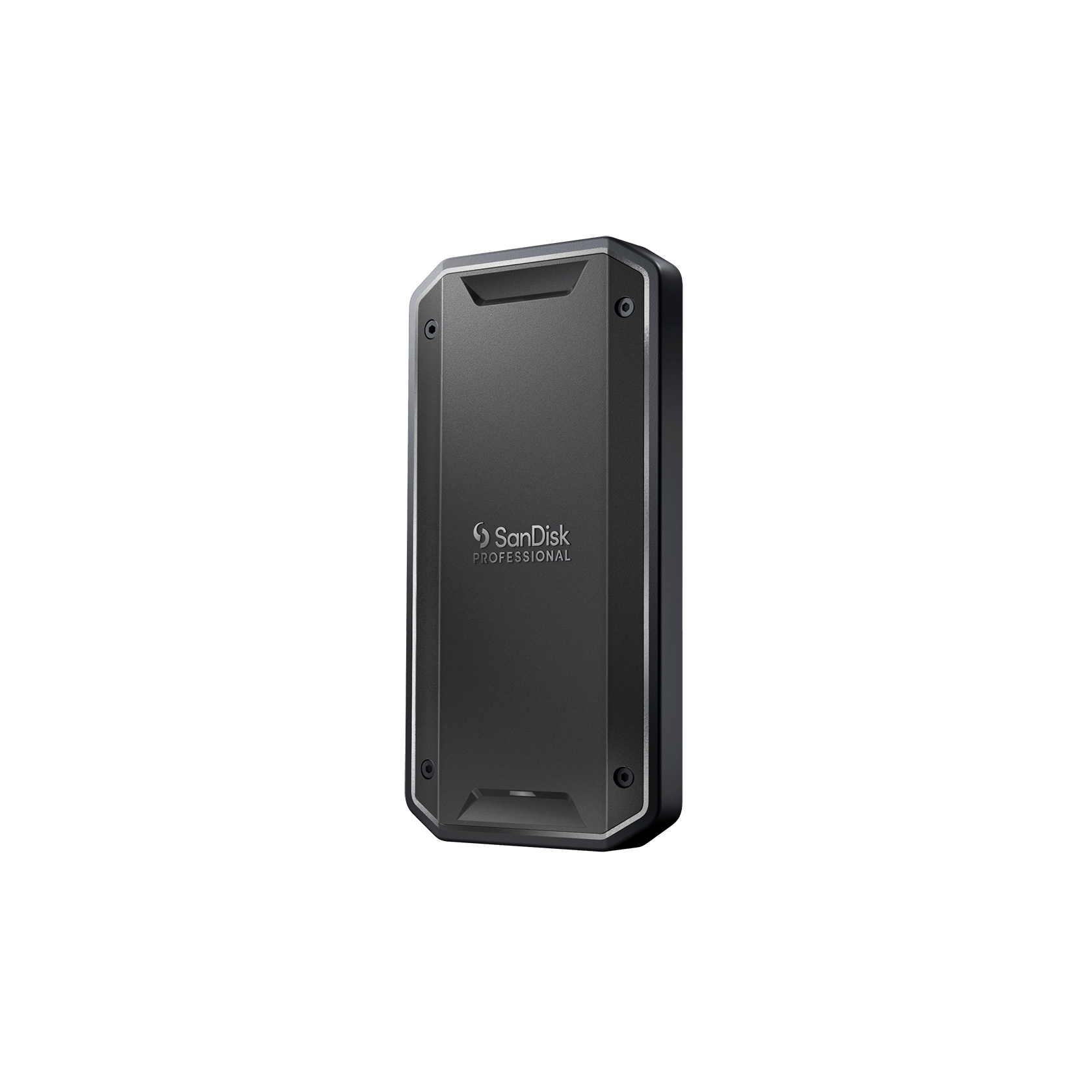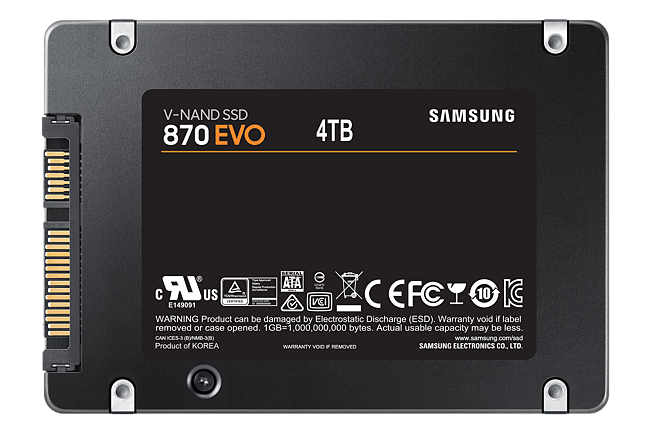Editing 4K video requires a lot of high spec equipment if you want to edit fluidly. The SSD you choose is one of them!
Now, I know what a lot of you are thinking out there… That I’m always talking about 4K video editing from NAS storage being the better investment option than external drives BUT I also am aware of budgets AND that not everyone needs a NAS.
So, that obviously leads us to the logical next question…
Which SSD drive is the best for video editing?
Though more specifically than that, I want to discuss which SSD drive is the best for editing 4K footage.
We’re passed the days of HDDs and HD video editing now, we want 4K and we want it now!
So let’s find that out, right now.
Watch the Video
Transfer Rate
The SSD drive we need will depend on the codec and format of 4K media we are going to be editing with.
As we know, not all flavours of video are the same and some are more data-hungry than others in terms of read and write speeds.
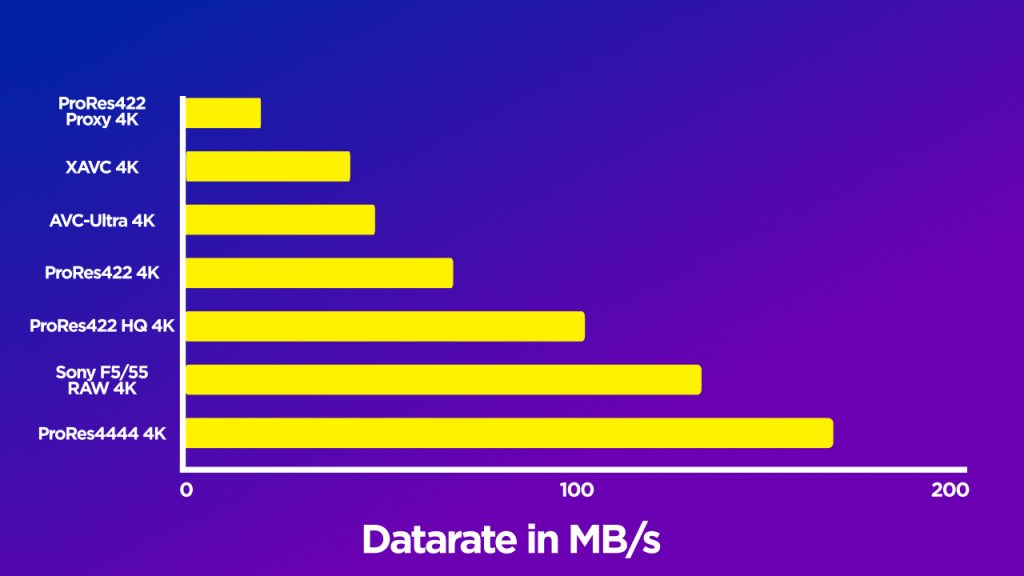
For the sake of this article and to be able to cover all bases we are going to assume that the highest level 4K footage we might be editing with is ProRes4444 (not XQ) and we’ll assume a normal frame rate of no more than 30fps.
This requires 165MB/s transfer rate.
Going down to ProResHQ and ProRes422 would require substantially less bandwidth.
Now, the other thing to bear in mind here is that this is for single-cam editing.
For multicam, you need to times that by the number of video streams, you intend to be editing with. Each stream of ProRes4444 will need 165MB/s.
So, to cover our bases there and assume we will be editing a fairly common 3-camera podcast setup, we will need between 495MB/s read and write speeds between the drive and the computer.
Why does all of this matter?
It matters because not every SSD drive offers the same read/write speeds either.
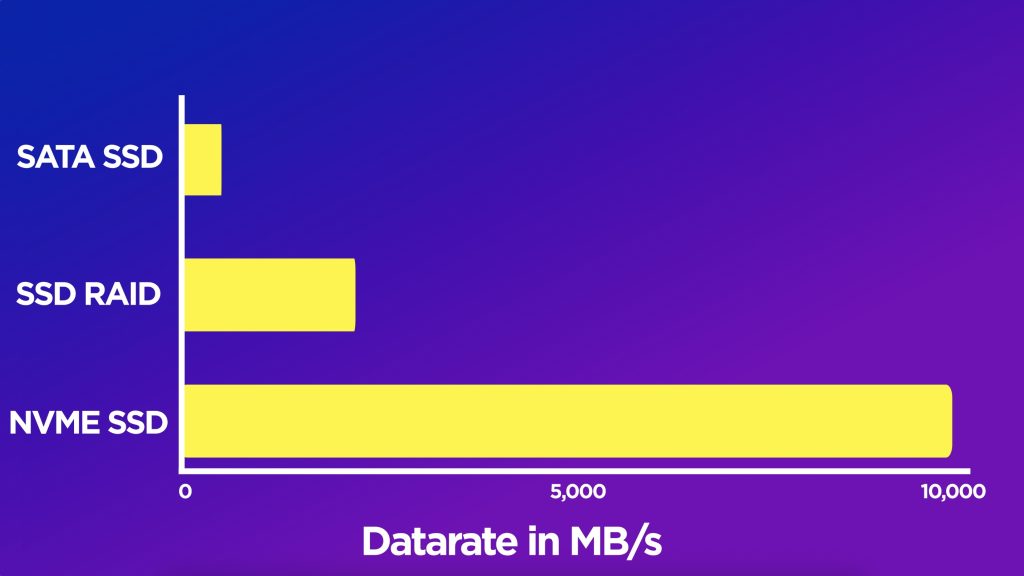
SATA SSD drives usually have speeds around 350-550MB/s.
SSD RAIDS can transfer speeds at around 2500-2800MB/s.
NVMe drives can transfer data at about 7000-10,000MB/s.
So you see, there are vast differences in the transfer rates for video codecs and the type of SSD drive too.
Internal or External
Another logical question is do you go with an internal drive or do you need an external drive to be able to move data around in the field?
Both have equal merit but both have limitations too.
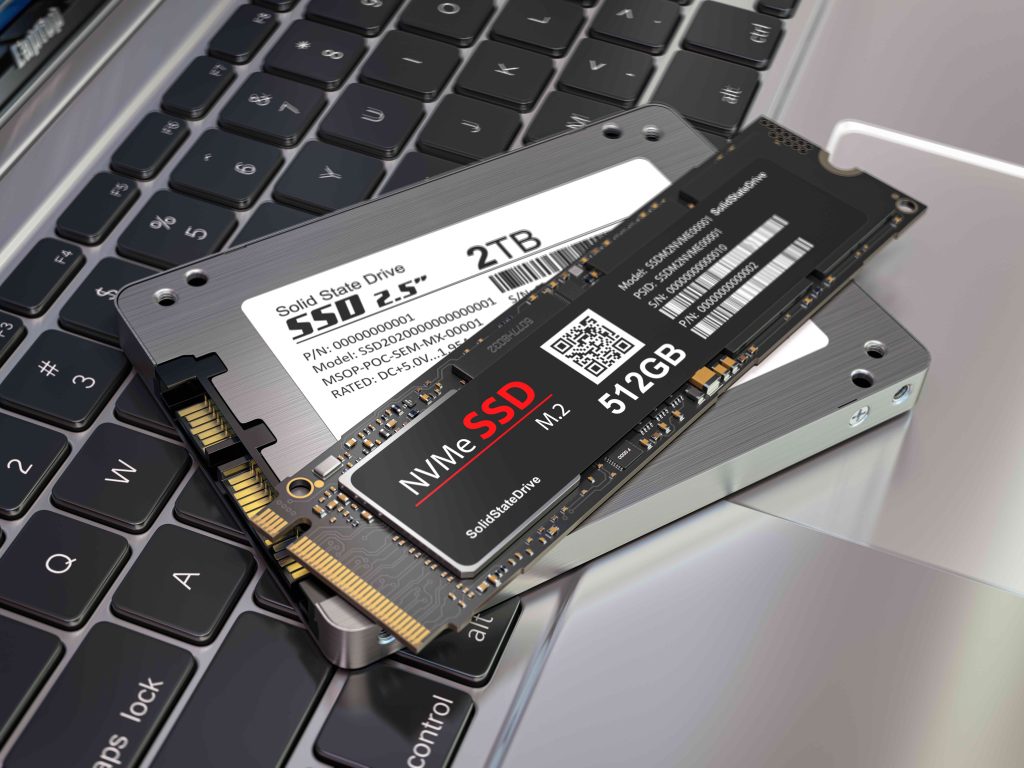
You will generally get better transfer speeds out of an SSD connected via PCIe or M.2 slots internally but you are limited then to using the SSD only on a desktop computer.

External SSD drives need to be connected via USB or Thunderbolt and as such, you are adding another component to think about when it comes to transfer speeds.
That is…
Cable speeds
Yep, you guessed it. How much data can the connection between your external SSD and the computer carry.
Different types of USB, which have recently been reclassified, have different capacities for transferring data. As does Thunderbolt, though you really only have Thunderbolt 3 or 4 to choose from these days.
Here you can see the speed difference between each of the different USB types.

We, therefore, need to choose a drive with a cable connection that will allow fast enough transfer of data to edit 4K footage as well.
And as you could see for single-cam editing we need a connection with at least USB 3.2 Gen 1 at 5Gbps which is 500MB/s. For multicam, this won’t be enough without using proxies.
Are We There Yet?
Nearly Pro Tippers, nearly.
There’s one more thing I want to mention before we look at the drives themselves and that is storage size.
While it doesn’t theoretically matter how much space you have to edit it does matter in terms of storing your 4K footage to edit with.
4K footage is inherently more data-heavy than HD footage and so you will need more space for the footage to reside while you edit from it.

500GB or even 1TB is not going to cut it when it comes to big uncompressed codecs like ProRes4444. At 165MB/s every 10 minutes of footage takes up 100GB of space. If you’ve been rolling for hours then you’re out of luck trying to store that on a small SSD.
Best SSDs for 4K Video Editing
Alright, so let’s split this up because not all of you will be looking for an internal SSD and not all of you will be looking for an external one either.
It’s worth mentioning at this point that you should be using any of these disks as your media scratch disks. Not for storing your operating system on and not for storing projects long term or to be reading and writing to at the same time.
I advise these disks be used to read data only to get the best editing experience.
DISCLAIMER: This post may contain affiliate links. We make a small commission if you buy the products from these links (at no extra cost to you). As an Amazon Associate and Skimlinks Affiliate, we earn from qualifying purchases. But we only recommend products we would use ourselves. For more information, click here to see our disclosures.
External SSD
SanDisk Professional 2TB Pro-G40 SSD
First of all the best external SSD with read/write speeds way above 500MB/s using USB 3.2 Gen 2 and with at least 2TB of storage space is the SanDisk Professional 2TB Pro-G40 SSD.
Why?
This thing has Thunderbolt 4 and USB-C compatibility.
Using Thunderbolt 3 you can read at 2700MB/s and write at 1900MB/s with theoretical 40Gbps connectivity.
If you’re using USB-C at 3.2 Gen 2 then you still get 10Gbps speeds and can read at 1050MB/s and write at 1000MB/s. More than enough for multicam editing of 4K Prores 4444 footage for 4 streams.
It uses a built-in NVMe disk to reach these speeds.
This thing is also IP68 dust/water resistant, up to 3m drop protection, and 4000lb. crush resistance.
It retails for $450/£500 and will have your editors absolutely flying through 4k and above footage.
No matter where your adventures may lead, the 2TB SanDisk Professional PRO-G40 SSD helps you store your important footage, including large raw images and 4K video files.
Samsung T7 Touch 2TB SSD
If your budget doesn’t stretch that far and you don’t need Thunderbolt speeds but still want 10Gbps speeds of 1050 and 1000MB/s read and write with added security then the Samsung T7 Touch has all of that.
It also has built-in security options utilising AES 256-bit encryption and gives you the option of unlocking with a touch of your finger or with a password.
It retails for $200/£225.
The Samsung 500GB T7 Touch Portable SSD is a compact and secure storage solution that offers users quick performance and little downtime with read and write speeds of up to 1050 MB/s and 1000 MB/s respectively.
Internal SSD
Ok, so let’s look at internal storage.
There are two roads to go down, SATA or NVMe via M.2 disks.
Unfortunately, SATA disks only reach speeds of around 550MB/s. This will do most single-stream 4K editors but if you are in the world of multicam this will significantly degrade your editing experience.
Samsung 870 EVO 4TB
However, they are cheaper and so my suggestion, if you’re looking at more bang for your buck in terms of storage size, would be the Samsung 870 EVO 4TB.
It has read speeds of 560MB/s and writes of 530MB/s and 4TB retails for around $265/£285.
Featuring sequential read speeds of up to 560 MB/s and sequential write speeds of up to 530 MB/s, making it ideal for storing and rendering large format files such as 4K video.
NVMe SSDs
Moving into the MUCH faster NVMe disk world I’ve got two astonishingly fast drives to show you.
Now, these disks can achieve these speeds because it connects directly to the motherboard without cables slowing it down and uses the fastest new PCIe ports.
So you’ll need to check if your motherboard can accept them or if you even have a slot available.
Samsung 990 PRO SSD
Using PCIe 4.0, which most computers in the last few years now have, you can get the blazing fast SAMSUNG 990 PRO SSD capable of read speeds of 7450MB/s and write speeds of 6900MB/s.
Yes, that’s 7.5GB/s!
It’s in an M.2 form factor so can be accepted in most M.2 slots.
2TB of this disk retails for $180/£180.
The Samsung 2TB 990 PRO PCIe 4.0 x4 M.2 Internal SSD offers an M.2 2280 form factor delivering sequential read speeds of up to 7450 MB/s and sequential write speeds of up to 6900 MB/s.
Gigabyte AORUS Gen5 10000 SSD
If you have a newer PC with PCIe 5.0 slots available then you can even go faster with the Gigabyte AORUS Gen5 10000 SSD.
This thing rips with read speeds of 10,000MB/s (yes, 10GB/s!!) and 9,500MB/s.
2TB retails for around $450-500/£350-400.
Bonus SSD Option
Ok, bonus disk time.
If you want the advantages of RAID storage but using SSDs and want Thunderbolt speeds then I have a beauty of a drive for you.
It’s called Thunderblade and it allows up to four M.2 NVMe drives to be housed together in a RAID configuration and has two Thunderbolt 3 outputs for speeds of up to 2800 and 2450MB/s read and write.
That means multiple editors can connect and you can even daisy chain them too.
It comes with disks already inside so you just need to buy the thing with as much storage as you want.
As an example, a 2TB version costs $900 but if you really want some storage capacity then 8TB of blazing fast portable storage costs $1550/£1750.
The 8TB ThunderBlade Thunderbolt 3 RAID Array from OWC. Boasting four M.2 NVMe drive bays housing four 2TB SSDs, this RAID array provides 8TB of total storage with read and write speeds up to 2800 and 2450 MB/s, respectively.
Fly Through Edits
Now, this is the part where I say, ‘This is great and all but how many of these drives will you inevitably end up buying each year when you run out of space all the time?’
You could, instead, invest in a NAS with an SSD cache in it and reap the rewards of SSD storage and long-term HDD storage all while getting 10Gbps speeds. So more than enough for multicam editing and you can have remote editing capabilities for the rest of the team too.
Check out my articles on Synology NASs here and how to edit remotely from them here.



